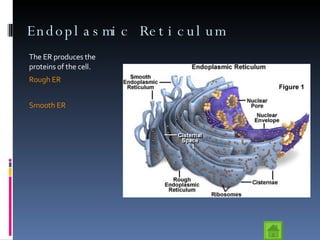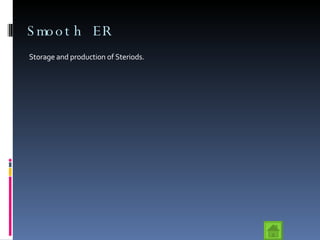Curtiswoodcell
- 1. Cell Biology BY: Curtis Wood
- 2. Cell Biology Animal Cells Plant Cells Nucleus Endoplasmic Reticulum Mitochondria Cell Membrane Vesicles Cytoplasm Golgi Body Nucleus Endoplasmic Reticulum Mitochondria Cell Membrane Vesicles Chloroplast Cell Wall Cytoplasm Golgi Body
- 3. Cell Wall Gives structure to plant cells . Are made mostly of cellulose. Plasmodesmata- are connections between cell to allow communication between cells.
- 4. Chloroplast Produces sugar for plant cells. Contains Chlorophyll a and b. gives plants leaves their green color.
- 5. Cytoplasm The viscous liquid that just about all the chemical reactions take place in. This liquid fills the cell.
- 6. Golgi Body Collects and secretes material, usually protiens, out of the cell.
- 7. Golgi Body How proteins get secreted by the Golgi body.
- 8. Cell Membrane Is the lipid bi-layer and proteins that act as a barrier between the inside and outside of a cell. Channel Proteins
- 9. Channel/Carrier Proteins Allows molecules in and out of the cell. Click the image for video-------------
- 10. Vesicles A membrane bound transporter in the cell. Exocytosis and Endocytosis
- 11. Nucleus Holds the genetic information of the cell. This information is held in the form of DNA
- 12. DNA This is the Genetic make up of the cell. The DNA is the blueprint for all the proteins in the an organism. It is made up of four bases and Sugar/Phosphate backbone. Four bases- Adenine Thymine Guanine Cytosine SEE HOW IT WORKS!!!
- 13. Endoplasmic Reticulum The ER produces the proteins of the cell. Rough ER Smooth ER
- 14. Rough ER This contains a protein complex known as a ribosome. This is where Protein synthesis occurs.
- 15. Smooth ER Storage and production of Steriods.
- 16. Mitochondria Mitochondria are the energy producers of the cell. They make ATP which is what the cell uses for energy. It produces between 36 and 38 ATP. ATP is the unit of energy that the body uses.















